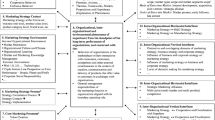Abstract
This paper examines the effects of consumer preferences, firms’ costs, and advertising efficiencies on firms’ pricing and persuasive advertising strategies. We show that as the firms’ horizontal differentiation increases, the firm with a lower value-added product tends to increase persuasive advertising, whereas its competitor tends to reduce advertising. Second, the firm receiving a favorable shock in product valuation will complement the favorable change with additional persuasive advertising rather than reduce advertising spending. Third, an equal improvement in advertising efficiency in the industry will lower the profits for both firms, whereas a decrease in advertising efficiency in the industry can benefit both firms. Fourth, a larger shock that improves a firm’s product valuation or unit cost is more likely to induce higher advertising spending in the industry. Lastly, an exogenous increase in the separation between firms’ product valuations or perceived qualities may actually reduce the price dispersion in the industry.
Similar content being viewed by others
Notes
The authors also study two alternative models of advertising; one assumes that advertising changes the ideal product variety, and the other assumes that advertising increases perceived product differences. To provide direct comparison in marketing implications, we focus on their case that assumes advertising raises the consumer’s willingness to pay since this is consistent with our model.
The parameter region of interest is k i > k (c) i for i ∈ {1, 2}, where \( {k}_i^{(c)}\equiv \frac{1}{3\left[3t-{V}_i+{V}_j+{c}_i-{c}_j\right]} \) for i ≠ j. In this paper, when the subscripts i and j appear in the same expression, it is always assumed that i ≠ j.
This relates to the Bertrand supertrap result by Cabral and Villas-Boas (2005), which shows that, in the presence of intra-firm product interactions, a positive shock in the industry (e.g., an increased degree of economies of scope or demand synergies) may lower equilibrium profits for all firms that compete on prices. Our result shows that a Bertrand supertrap is also possible for single-product firms that strategically compete on both prices and advertising.
References
Adams, W. J., & Yellen, J. (1977). What makes advertising profitable? The Economic Journal, 87, 427–449.
Amaldoss, W., & He, C. (2010). Product variety, informative advertising and price competition. Journal of Marketing Research, 47, 146–156.
Bagwell, K. (2007). The economic analysis of advertising. M. Armstrong, R. Porter (eds). Handbook of industrial organization, Vol. 3, Chapter 28. North-Holland, Amsterdam.
Bloch, F., & Manceau, D. (1999). Persuasive advertising in Hotelling’s model of product differentiation. International Journal of Industrial Organization, 17, 557–574.
Cabral, L., & Villas-Boas, M. (2005). Bertrand supertraps. Management Science, 51, 599–613.
comScore. (2007). The Kelsey Group. “Online consumer-generated reviews have significant impact on offline purchase behavior.” comScore Press Release.
Grossman, G., & Shapiro, C. (1984). Informative advertising with differentiated products. Review of Economic Studies, 51, 63–81.
Hermalin, B. (1993). Notes on microeconomics. Berkeley: University of California.
Iyer, G., Soberman, D., & Villas-Boas, J. M. (2005). The targeting of advertising. Marketing Science, 24, 461–476.
Tirole, J. (1988). The theory of industrial organization. Cambridge: MIT.
von der Fehr, N. H., & Stevik, K. (1998). Persuasive advertising and product differentiation. Southern Economic Journal, 65, 113–126.
Author information
Authors and Affiliations
Corresponding authors
Electronic supplementary material
Below is the link to the electronic supplementary material.
ESM 1
(DOCX 45 kb)
Rights and permissions
About this article
Cite this article
Jiang, B., Srinivasan, K. Pricing and persuasive advertising in a differentiated market. Mark Lett 27, 579–588 (2016). https://doi.org/10.1007/s11002-015-9370-1
Published:
Issue Date:
DOI: https://doi.org/10.1007/s11002-015-9370-1




